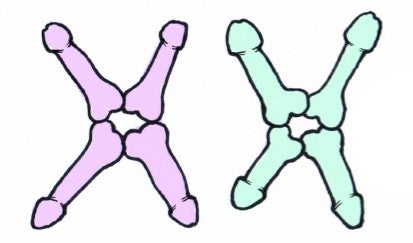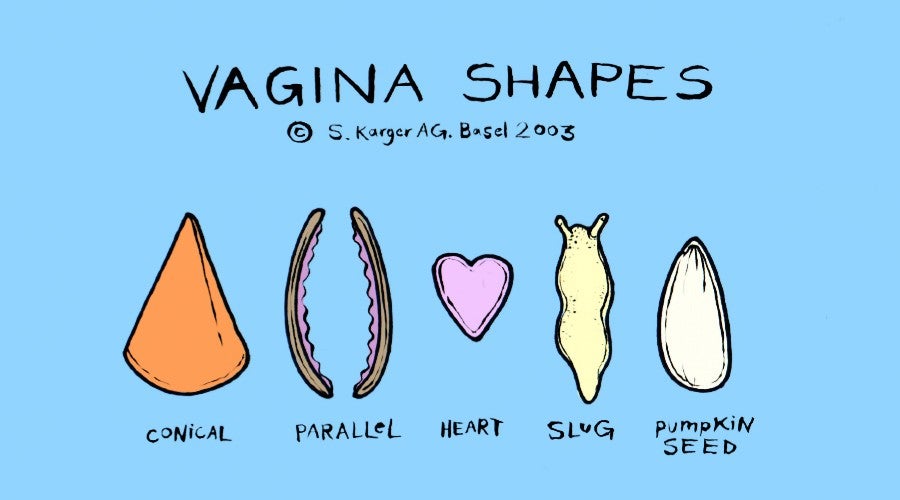Updated 6/4/2022
In a boring, homogeneous world, guys everywhere would have the same hair, the same body, the same dick. And every woman would have the same shape, and their vaginas would be the same size and color. On the one hand, it’d be pretty utilitarian to know exactly what you’re getting into when someone’s (anyone’s) pants come off. On the other, there’d be no mystery — and where’s the fun in that?
Luckily, we don’t live in this predictable world where when you’ve seen one penis or vagina you’ve seen them all — far from it. What our genitals look like is determined by a variety of factors, the biggest being human genetics, which can produce incredibly varied, sometimes curious results.
But figuring out who in your family tree you can thank (or scream at) for the size of your penis is far trickier. Of course you inherit your genes from your mom and dad, but their genes are also a mix of their parents’ genes, which are a mix of their parents’ parents’ genes, and so on, stretching all the way back to when the first proto-humans crawled out of the primordial ooze.
So, to really get at what determines penis size, let’s take it from the beginning.
Getting Into Your Genes
For the first seven weeks of fetal development, both male and female fetuses look the same, complete with nondescript sexual organs. If you were given a Y chromosome from your father, around week eight you’ll start developing testes and the rest of the components of male genitalia, including the penis. If instead you got another X chromosome to go along with the one passed down from your mother, you’ll get a set of ovaries and female genitalia. What you’ll be working with for the rest of your life is essentially determined at this point.
While dad decides if you’ll be sporting a penis or vagina, what you get from your maternal side has a say in how those genitalia will turn out. “This is an area that isn’t completely understood, but many genes involved in the growth of penis and limbs come from the X chromosome,” explains Darius Paduch, director of sexual health and medicine at Weil Cornell. “Men have one X chromosome, and women have two. Since boys always inherit the X chromosome from the mother and the selection of that X chromosome is random, this can explain why one brother may have inherited genes for a large penis from one of the mother’s X chromosomes, but another brother inherited an average-size penis from the other.”

That said, according to Paduch, most men in a family do tend to share a similar dick length and shape. “If a father has a bigger penis, the son’s will probably be similar in length,” he says. Kind of like how if your father is tall, you will more than likely be tall as well. But it’s not so much a guarantee as it is an educated guess.
Genetic Grab Bag
Dormant genes also are passed down from generation to generation, which is why some short parents can end up with a tall kid, while others have a redheaded child when neither Mom nor Dad has red hair. The genes are in there somewhere—just not necessarily around for all to see.
Additionally, humans have about 200 genes that scientists call “de novo mutated,” meaning that they’re ever-so-slightly different than the genes you got from your parents. In practice, this can be as simple as having a dick that looks like your dad’s, but is longer or thicker or leans more to the left. Our genes may provide a roadmap for our traits and features, but as with any road trip, you should always prepare for the unexpected.

Other Outside Influences
Despite the finality that “written in your DNA” suggests, genetics can be altered by your environment. As your body develops, the hormones you’re exposed to can influence growth. Research by scientists at the University of Edinburgh has found that penis length is predetermined by hormones during a certain time frame early in fetal development. Hormonal exposure after this period can speed up growth, but it won’t increase the size eventually reached in adulthood.
Unfortunately, however, it can decrease size. “Exposure to certain environmental estrogens or contaminants as you enter into puberty has been associated with shorter penises,” Paduch says. Chemicals called endocrine disruptors, which can be found in pesticides, plastics and some cosmetics, among other everyday things, are bad news for both your penis and your overall health. Malnutrition, in utero and during the first few formative years of life, can also stunt your growth (dick included).
“The penis grows in thickness and length with the onset of puberty and stops growing in length in mid-to-late puberty,” Paduch says. “Its growth is regulated or driven by two hormones: testosterone and growth hormone. Testosterone seems to relate more to length, and growth hormone to girth, but we need both of them. What’s fascinating is that despite the fact that men produce testosterone all their lives, the penis doesn’t grow indefinitely, though the girth may increase slightly with age even after puberty.”
Before you try injecting HGH or testosterone thinking it will increase your dick size, it won’t. Any anecdotal claims of guys gaining an inch or two after supplementing with these hormones aren’t reliable. Studies done on prepubescent boys with growth-hormone deficiency have shown positive results in terms of penis size after HGH therapy, as has testosterone treatment for kids with micropenises associated with pituitary problems, but this is largely because these issues were treated while the penis was still developing.
Your Average Penis Size
In the end, though, 95 percent of guys grow up to have an average-size penis—which, according to a 2015 review of several studies published in BJUI International, is about 3.6 inches long and 3.7 inches thick when flaccid, and about 5.2 inches long and about 4.6 inches thick when erect.
As far as big hands, big feet and other larger body parts being a predictor of big dicks, there’s no definitive research that proves (or dispels) the connection. A variety of studies (some survey-based, others more scientific) have tried to link things such as BMI and index finger length or ratio to penis size, but, as the authors of the BJUI review noted, “Correlations with other [parts of the body] were either inconsistent or weak.”
What determines penis size doesn’t have much to do with hands and feet, or even race (another popular misconception). “There are geographic variations in penis size, but they’re more related to overall body length and build rather than ethnicity,” Paduch explains.
So when it comes to guessing what size a guy is, the only things you can really go off are height and overall proportion.

The Many-Faced Goddess
Vaginas — and the external parts you actually see, called the vulva — defy quantification. There’s a general structure, but there’s so much variation that researchers struggle to define what is “normal.” There’s also not much research for them to go on.
One study used a casting method (similar to dental casts) to come up with five funny-sounding general vaginal shapes: conical, parallel sides, heart, slug and pumpkin seed. But according another study that tried to figure out what an average vagina looked like, “There are surprisingly few descriptions of normal female genitalia in the medical literature. In contrast, measurements for male genitals are widely available and were published as early as 1899.”

That study did its best to kick off such research by examining the vaginal sizes of 50 participants. Its main finding: “A wide range of values were noted for each measurement. There was no statistically significant association with age, parity [the number of vaginal births], ethnicity, hormonal use or history of sexual activity.” A later study echoed that conclusion, “No one description characterized the shape of the human vagina.”
The issue with these studies (and the handful of others done on female anatomy) is that the appearance and measurements of the vulva and the vagina aren’t static, making them hard to measure. Like penises, vaginas change when aroused; external parts swell up and the vaginal cavity itself loosens and elongates so the object of your choice can enter—to say nothing of the temporary changes that come with childbirth. Given all this fluctuation, it should be noted that there’s absolutely no such thing as a “worn-out” vagina or any other such bullshit.
Use What Your Mama (or Papa) Gave You
While there isn’t much you can do to alter the hand you were dealt by genetics, when it comes to dick size, how often you’re getting hard can absolutely make a difference. As Paduch recommends, “Use your penis; many studies show that shrinkage can be related to not getting enough erections.” If anything, all that worrying can have a negative effect. “Most men in their 20s who worry about their penis size are anxious and stressed, and a high level of adrenaline from anxiety and stress can lead to penile shrinkage and retraction — I call it a rubbery penis,” Paduch says. “With age, most men learn that size is a really minor part of happy sex and relationships.”
So whether you’re proud or slightly ashamed about what your dad, mom or strangely charismatic great-grandpa may have contributed to your sex life, accepting what nature gave you is pretty much the only productive thing you can do. Easier said than done, true. But let’s be honest — most of us aren’t exactly taking notes when we’re getting down and dirty, so who’s really examining your junk and all of its fleshy nuances in great detail? Unless you’re a porn star, the answer is probably just you.
Your Hardest Questions About Dicks, Answered
- What is an average flaccid penis? Here’s the truth about “grower vs. shower.”
- A historical look at Milton Berle’s supposedly giant penis.
- Is “summer penis” real?
- Do you get your penis size from your mom or your dad?
- Inside Jackinworld, the internet’s first masturbation forum.
- To many people, penis girth matters more than penis size.
- What’s in delay spray for premature ejaculation?
- What does a Penuma implant look like? Penis surgery, explained.
